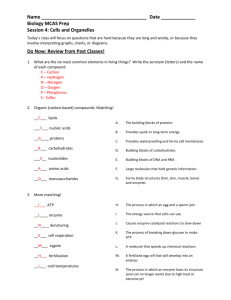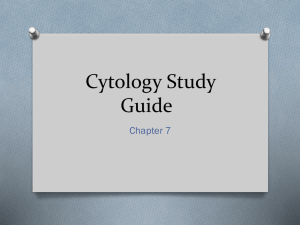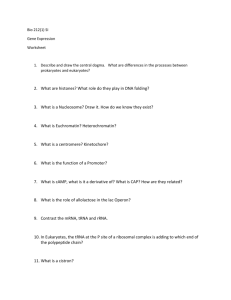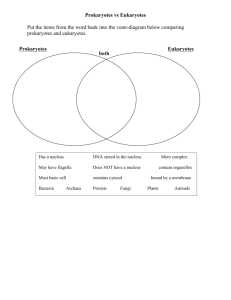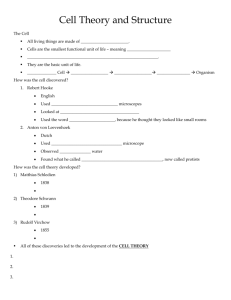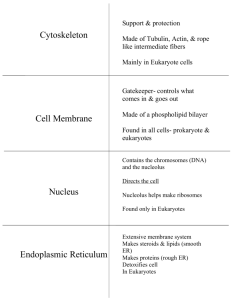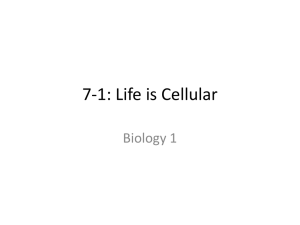The Cell part 2(website)
advertisement
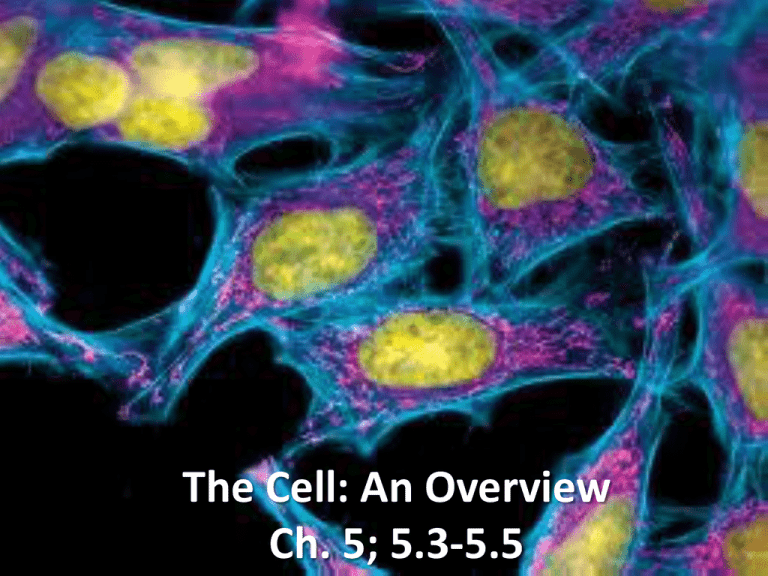
The Cell: An Overview Ch. 5; 5.3-5.5 Eukaryotes: The Nucleus • Nucleus is membrane bound nuclear envelope (2x layer) • How do things move through the envelope? – Just like the plasma membrane, proteins (nucleoporins) channels allow entrance (nuclear pore complexes) • How do they know what goes in? – Short AA sequence (nuclear localization signal) acts like a zip code for the nucleus Eukaryotes: The Nucleus • What do you find inside the nucleus? 1) nucleoplasm cytoplasm in nucleus 2) Chromatin DNA/Protein complex 3) Chromosomes condensed DNA 4) Nucleolus mixture of gene regions and RNA complexes Eukaryotes: Ribosomes • Why do we have free floating and membrane bound ribosomes? – Different products for different environments 1) Free ribosomes produce proteins to be used in the cytosol 2) Attached ribosomes produce proteins to be embedded in membranes or secreted • Both have complex organelle path after completion Eukaryotes: Endoplasmic Reticulum • Smooth ER makes lipids and digestive enzymes for drugs and toxins • Rough ER makes secreted proteins and digestive enzymes • What cells in the body would have the largest smooth and rough ER? – Liver cells (smooth) – Digestive tract (rough) Eukaryotes: Golgi Complex • Rows of flatten sacs (cisternae) receive vesicles from areas of the cell (at cis face), modify the contents, and send them to their next location (at trans face) • Most proteins are embedded or secreted (exocytosis) • Some molecules drawn into the cell (endocytosis) and destroyed by fusion with lysosomes Eukaryotes: Lysosomes • Digestive sacs in animals cells (over 300) that act like recycling centers • Acidic (pH ~5) • Why is it important they only work in a high pH? – Lowers risk of activity outside of lysosome; wont work in basic cytosol • Enzymes made in rough ER and then vesicle formed from Golgi complex • Roles: – Autophagy digest useless organelles – Phagocytosis digest bacteria pulled into the cell Eukaryotes: Mitochondria • Site of cellular respiration • Double layered membrane with reactions between the cristae and the matrix • What about mitochondria suggest that they used to be independent organisms? – The have their own DNA and ribosomes Eukaryotes: Microbodies • Large vesicles that do various tasks: – Phospholipid synthesis – Breakdown fats and proteins to make ATP – Breakdown toxins • Peroxisomes vesicles of catalase • What do they do? – Breakdown hydrogen peroxide Eukaryotes: Cytoskeleton • Reinforce cell shape and allow movement around the cell • Like your organs, a cells organelles must be held in place • 3 groups: 1) Microtubules 2) Intermediate Filaments 3) Microfilaments Eukaryotes: Microtubules • Long, wide tubes (25nm) made of α and β tubulin • Charge ends, with more activity on the + end • Why do they need charged ends? – Can use ionic forces to hold them in place in the cell • Network radiates from the cell center (centrosome) and have two perpendicular barrels (centrioles) • Hold organelles in place and are tracks for vesicle movement – Motor proteins (kinesins and dyneins) Eukaryotes: Microtubules • Main part of flagella and cilia • 9 + 2 complex 9 double tube units around 2 single tube units • Wave and oar-like movements push cell through mediums • Flagella are found in all 3 domains, but their genes are different. What does this tell us about flagella evolution? – It was independent even though they have the same structure and function Eukaryotes: Intermediate Filaments • Medium sized (8-12nm) fibers that connect microtubules/ microfilaments together; adds stability • Not found in single-cell organisms • Tissue specific have different proteins depending on the what part of the organism they are in Eukaryotes: Microfilaments • Thin fibers (5-7nm) of actin units • Charged ends with more growth on the + end • Main part of muscle tissue – Myosin (motor protein) moves back and forth along microfibers causing contractions • Cytoplasmic streaming movement of the cytoplasm – Cause amoeboid movement – Divided cytoplasm during division Eukaryotes: Chloroplasts • Plastid – Amyloplasts starch forming cells (potato) – Chromoplasts red and yellow pigments give color to fruits and autumn leaves • Double membrane around the stroma (inner area) which is filled with a 3rd membrane that makes the thylakoids/grana • Thylakoids have chlorophyll pigments that absorb light energy • How are chloroplast and mitochondria similar? – Both have their own DNA and ribosomes Eukaryotes: Central Vacuole • Functions are giant lysosome for the cell; also a storage unit • Stores pigments that give flowers their color • Tonoplast channels that allow transportation of materials • Turgor pressure pushes against weight of cell well – What happens with plants are low on water? • The wilt; sag because turgor pressure drops Eukaryotes: Cell Wall • Extracellular Structure • Primary soft/flexible layer expands as cell grows • Secondary harder cellulose fibers used to strengthen wall – lignin complex alcohol structure stronger than concrete (by weight) • Polysaccharide layer (middle lamella) acts like glue to hold plant cells together – Pectin used in syrup and jams • How do cells communicate through these think walls? – Channels (plasmodesmata) allow instant communication between plant cells Homework • Read Ch. 6 • Vocabulary for Ch. 6 • “Test Your Knowledge” Multiple choice questions on p. 114 and “Interpret the Data” on p. 115
